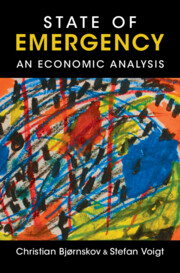Book contents
- State of Emergency
- State of Emergency
- Copyright page
- Contents
- Figures
- Tables
- Acknowledgments
- 1 Introduction
- 2 The Architecture of Emergency Constitutions
- 3 The Determinants of Emergency Constitutions
- 4 Why Do Governments Call a State of Emergency?
- 5 The Effectiveness of Emergency Constitutions after Natural Disasters
- 6 When Does Terror Induce a State of Emergency? And What Are the Effects?
- 7 States of Emergency after Domestic Turmoil
- 8 Dealing with Disaster
- 9 Keeping up the Balance between the Federation and the States
- 10 Constitutionalized Media Freedom during Emergencies
- 11 Unconstitutional States of Emergency
- 12 The COVID-19 Pandemic, States of Emergency, and Reliance on Executive Decrees
- 13 Returning to the Status Quo Ante?
- 14 Contracting for Catastrophe
- 15 The Future of States of Emergency
- References
- Index
9 - Keeping up the Balance between the Federation and the States
Published online by Cambridge University Press: 01 November 2024
- State of Emergency
- State of Emergency
- Copyright page
- Contents
- Figures
- Tables
- Acknowledgments
- 1 Introduction
- 2 The Architecture of Emergency Constitutions
- 3 The Determinants of Emergency Constitutions
- 4 Why Do Governments Call a State of Emergency?
- 5 The Effectiveness of Emergency Constitutions after Natural Disasters
- 6 When Does Terror Induce a State of Emergency? And What Are the Effects?
- 7 States of Emergency after Domestic Turmoil
- 8 Dealing with Disaster
- 9 Keeping up the Balance between the Federation and the States
- 10 Constitutionalized Media Freedom during Emergencies
- 11 Unconstitutional States of Emergency
- 12 The COVID-19 Pandemic, States of Emergency, and Reliance on Executive Decrees
- 13 Returning to the Status Quo Ante?
- 14 Contracting for Catastrophe
- 15 The Future of States of Emergency
- References
- Index
Summary
Emergency provisions allow governments to intervene swiftly, but also create opportunities for political capture. We analyze how this tension plays out in the largest federal republic in the world, India. Article 356 of the Indian Constitution (known as president’s rule) allows the union (federal) cabinet to dismiss a functioning state government and dissolve the elected state legislature, if the federally appointed state governor recommends the dismissal due to political crises, natural disasters, riots, and so forth. Using an original panel dataset of Indian states from 1952 until 2019, we find that emergency provisions allow for political capture increasing federal dominance in India. We find that: (1) the likelihood of invoking Article 356 is almost exclusively determined by the political strength of the parties in majority/coalition governments at the state level; (2) emergencies like riots and natural disasters are not significant predictors of invoking Article 356; and (3) judicial safeguards added in 1994 significantly reduced the imposition of Article 356.
Keywords
- Type
- Chapter
- Information
- State of EmergencyAn Economic Analysis, pp. 226 - 256Publisher: Cambridge University PressPrint publication year: 2024

